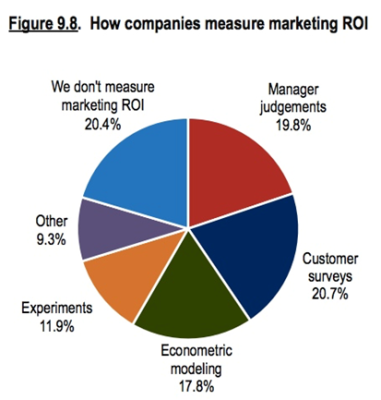The New Year & The New CMO: 3 Key Predictions For 2015
Digital marketing is always evolving, and that means CMOs have to evolve as well. Columnist Jim Yu shares his predictions for what CMOs will need to focus on in the new year.

Chief marketing officers have no doubt earned their ranks, and they have a big job to do for their brands. Not only must they bring their skills and experience to 2015, they must also be ready and willing to embrace change in order to stay a step ahead of the competition.
In this post, I’ll share three predictions that CMOs should prepare for in the coming year, which include:
- Marketing analytics and ROI will be the CMO “source of truth” for continued content marketing investment
- Organic search and content will continue to be the channels to watch
- Scaling your marketing will require new CMO skills
Prediction #1: Marketing Analytics & ROI As The CMO Source Of Truth
It’s estimated that by 2017, 12 percent of the marketing budget will be allocated to marketing analytics. That’s a 75 percent increase from 2014, according to CMOSurvey.org, which collects data from U.S. marketers at the VP level or above at Fortune 1000 and Forbes Top 200 companies.
The fact that a growing portion of budget will be rationed to analytics shows that CMOs understand the importance of data-driven decisions. Unfortunately, “big data” without actionable insights continues to be the challenge.
The research at CMOSurvey.org shows that marketing analytics is falling flat for many and only somewhat contributes to a company’s performance across the board. That’s likely because 67 percent said they don’t formally evaluate the quality of their marketing analytics, and only 33 percent say they can prove the long-term impact of marketing quantitatively.
Right now, there’s a startling gap in how big brands are measuring marketing ROI, with 20 percent saying they don’t at all, and the next biggest percentage (21 percent) relying on customer surveys:
So, how will you handle “big data” and the return on investment in your marketing analytics in 2015?
Below are a couple of tips:
Evaluate The Analytics Software To Ensure It’s A True Platform
With big data, the problem is often fragmented data points from multiple tools, with people being in the middle of trying to reconcile that data.
When you use the right platform for marketing analytics, it should integrate and process important data from multiple places, standardize the data into a simple format, and output insights gleaned from processing all that information together.
Create Manageable And Practical Key Performance Indicators
With all the data available at our fingertips, it’s easy to want to follow everything to its end. But this approach is inefficient, producing endless “rabbit holes.” Instead, track only the handful of KPIs that matter to the unique marketing strategy and exclude everything else.
Prediction #2: Organic Search & Content Continue To Be The Channels To Watch
Back in August, I highlighted data that showed organic search was the largest driver of traffic to B2B and B2C websites, according to data forged by BrightEdge’s massive data repository, the Data Cube, earlier this year.
We also found that most of the sectors studied experienced the most return in the form of revenue from organic traffic – even over other channels like paid search, email and social.
Other studies have echoed the focus that marketers have on the organic channel. The Content Marketing Institute’s 2015 “B2B Content Marketing Benchmarks, Budgets and Trends North America” report showed 81 percent of marketers created content on their website as their “content marketing” weapon of choice, and 80 percent used blogs – both strategies that fuel organic search performance.
But “winning” in organic search is multifaceted and goes beyond just creating articles and blogs. In order to compete in organic search, following are a few things to consider in 2015.
Make Sure You’re Catering To Your Ever-Growing Mobile Traffic
Google has suggested that having a mobile-friendly site can make or break you in the mobile search results. And, it just released its “mobile-friendly” labeling, to boot. Add to that the fact that if you do have a mobile site, Google wants important page content to render in one-second or less, and it gives plenty of tools for webmasters to identify page speed problems and issues impacting the mobile experience.
At the very head of this mobile traffic opportunity is deciding which type of mobile configuration is best for your audience; and remember, responsive is not always a one-size-fits-all approach.
Target Demand & Uphold Quality In Your Organic Content
SEO and content help one another out in tremendous ways. Through analytics data, SEO can help content creators follow the right topics that are driving demand by the target audience.
In turn, content creators help build the brand experience by providing the most useful content for that topic. One step further, SEO practices optimize the content so that it can be found for a searcher’s query on the search engine results page.
In the 2015 CMO predictions at Forbes.com, marketers say this coming year will put a tremendous focus on the customer, and that brands will further explore their ability to be publishers. Together, publishing content with a focus on the customer that’s reinforced by SEO will help brands win in organic search.
Prediction #3: Scaling Your Marketing Will Require New CMO Skills
Your digital marketing efforts support multiple business units, competing goals and are constantly under scrutiny. In fact, it might sometimes seem like scaling your marketing to support more teams and more revenue is a far-off ideological concept. You’re not alone.
CMOSurvey.org research (referenced earlier) showed only 56 percent said marketing was responsible for lead generation within their company. Add to that the fact that 62 percent say there is pressure from their boards to prove the value of marketing, and 65 percent say this is an increasing pressure, and we start to see the gap here. And that gap is the ability to scale.
Achieving this ability not only ties to the first prediction in this post – getting the right analytics in place to prove ROI, but also the second prediction – following the channels that show the most return. But in order to do this, the CMO needs to embrace his or her changing role.
In this Forbes article that highlights discussion points from the CMO Exchange conference in 2013, it points out the changing role of CMOs and what that entails. Just some of the key points discussed include:
- A role change for the CMO from a marketing leader to a company-wide, change-management officer
- Effective CMO and CIO collaboration (something that’s needed to succeed in today’s digital marketing)
If you want to be a change agent, and scale your marketing efforts in 2015, consider the following:
Get The Right People In Place & Learn
Don’t understand big data? Have no clue about multi-channel attribution? That’s OK for now, so long as you get the right people in place on your marketing team and start learning from them — immediately.
What if you have the right people, but lack the skills? Start ramping up those skill sets with strategic continuing education (for you and your team) and hands-on projects that allow you to fail and learn from your mistakes, or win and revel in your executions.
Right now, many believe we are facing a talent and skills gap. This article at Huffington Post shares some alarming stats, like 75 percent of marketers say lack of skills is impacting revenue, and that the U.S. could face a massive shortage (up to 190,000 people by 2018) with skills in deep data analysis.
The faster you can take this challenge head on, the faster you can secure the future of your marketing efforts and your CMO role.
Put A Priority On Relationships & Communication
You’ve probably heard this before, but the relationships you create within the organization, and the wins you can demonstrate through marketing in support of specific needs can help create buy-in for more marketing.
While every organization is unique in the way they approach marketing, today is vastly different than even five-years ago, and your organization must learn that, too. The only way to do that is through effective communication via the relationships you create with stakeholders and the ROI you can show as a result.
So in closing, you can probably see how each one of these predictions is intertwined with one another, which actually perfectly illustrates the face of digital marketing today. It’s holistic, and it needs both a sturdy foundation and the embracing of trends and new practices.
How will you prepare for the new year and the new CMO role in 2015?
Contributing authors are invited to create content for MarTech and are chosen for their expertise and contribution to the search community. Our contributors work under the oversight of the editorial staff and contributions are checked for quality and relevance to our readers. MarTech is owned by Semrush. Contributor was not asked to make any direct or indirect mentions of Semrush. The opinions they express are their own.
Related stories

